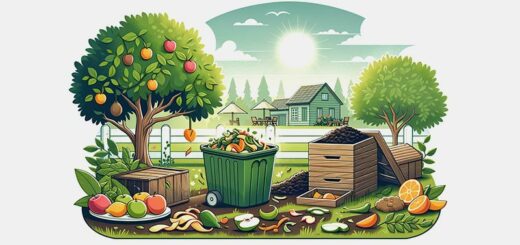How Much Compost Do I Need? A Comprehensive Guide
Gardening enthusiasts know that a thriving garden starts with healthy soil, and compost is often hailed as the “black gold” of the gardening world. But how much compost do you need to achieve the lush, bountiful garden of your dreams?
This comprehensive guide will explore the importance of compost, the factors determining your need, and how to apply it effectively to your garden.
By understanding the benefits of composting and the correct application rates, you’ll be well on your way to nurturing vibrant, flourishing plants and reaping the rewards of your gardening efforts.
Understanding Compost and Its Benefits
Compost is a nutrient-rich, organic material created by decomposing plant and animal waste, such as leaves, grass clippings, kitchen scraps, and manure. By breaking down these materials into a dark, crumbly substance, compost is an excellent soil conditioner, providing numerous benefits to the soil and the plants growing in it.
Improved soil structure: Compost helps to enhance the texture and structure of the soil by adding organic matter. This makes the soil more porous and well-draining, promoting healthy root growth and allowing plants to access essential nutrients and water more easily.
Enhanced nutrient content: Compost is rich in essential nutrients, such as nitrogen, phosphorus, and potassium, that plants need to grow and thrive. They act as a natural, long-lasting fertilizer that helps sustain plant growth and productivity by slowly releasing these nutrients.
Water retention: The organic matter in compost can significantly increase the soil’s water-holding capacity, reducing the need for frequent watering and making your garden more drought-tolerant. This conserves water and ensures that your plants receive consistent moisture for optimal growth.
Pest and disease control: Compost introduces beneficial microorganisms that help to suppress harmful pathogens and pests. By promoting a healthy balance of microbes in the soil, compost can reduce the need for chemical pesticides and create a more resilient garden ecosystem.
Environmental benefits: Composting is a sustainable practice that helps divert waste from landfills and reduces the need for synthetic fertilizers. By incorporating compost into your garden, you are improving your soil and contributing to a healthier environment.
How to determine the amount of compost needed
To determine the right amount of compost for your garden or planting area, it’s essential to consider several factors, including the size of the area, soil type, and the specific requirements of the plants being grown.
Follow these steps to calculate the appropriate amount of compost for your needs:
Measuring your garden or planting area: Begin by measuring the length and width of your garden or planting area to calculate its total square footage. This information is crucial for determining the compost needed based on the recommended application rates.
Assessing your soil type and condition: Examine the soil in your garden to determine its type and condition. Different soil types (e.g., sandy, clay, or loamy) and conditions (e.g., nutrient-rich or depleted) will require different amounts of compost to achieve optimal results.
In general, sandy and nutrient-depleted soils need more compost than loamy or nutrient-rich soils.
Calculating the compost application rate: Once you know your garden’s square footage and have assessed your soil type and condition, you can calculate the compost application rate.
Generally, a layer of 1 to 3 inches of compost is recommended for most gardens, with 1 inch for maintaining soil health in an established garden and 2 to 3 inches for improving soil conditions or starting a new garden. To convert this to cubic yards or cubic feet, use the following formula:
(Garden area in square feet) × (Desired compost depth in inches) ÷ 12 = Compost needed in cubic feet
(Compost needed in cubic feet) ÷ 27 = Compost needed in cubic yards
Adjusting for specific plant requirements: Remember that certain plants may require more or less compost than the general recommendation. For example, heavy-feeding plants like tomatoes, squash, and corn may benefit from a higher application rate.
In contrast, plants that prefer low-nutrient soils, like lavender or blueberries, may need less compost. Adjust your calculations to meet the specific needs of your growing plants.
Types of Compost and Their Application Rates
Various types of compost are available, each with its own characteristics and application rates. Understanding the differences between these types can help you choose the best compost for your garden and apply it at the appropriate rate.
Homemade compost: Homemade compost is created by combining kitchen scraps, yard waste, and other organic materials in a backyard compost pile or bin. The nutrient content of homemade compost can vary widely depending on the materials used and the composting process.
As a general rule, apply 1 to 3 inches of homemade compost to your garden, with a higher application rate for improving poor soil conditions or starting a new garden.
Commercial compost: Commercial compost is produced on a larger scale using controlled processes to ensure consistent quality and nutrient content. It is typically sold in bags or bulk and may be derived from various sources, such as food waste, yard waste, or municipal composting programs.
Follow the manufacturer’s recommended application rates, which usually range from 1 to 3 inches, depending on your soil type and garden needs.
Animal manures: Animal manures, such as cow, horse, chicken, or rabbit manure, can also be used as compost. These manures are rich in nutrients, particularly nitrogen, but should be well-aged or composted before use to avoid burning plants or introducing harmful pathogens.
Apply a 1/2 to 1-inch layer of composted animal manure to your garden, taking care not to over-apply, as excess nutrients can cause problems for your plants.
Compost amendments and specialty products: In addition to traditional compost, there are various specialty compost products and amendments on the market, such as worm castings, mushroom compost, or compost tea. These products are typically used to supplement regular compost applications, providing additional nutrients or microbial benefits.
Follow the manufacturer’s instructions for proper application rates and methods.
When choosing the type of compost for your garden, consider factors such as availability, cost, and the specific needs of your plants. Regardless of the kind of compost you choose, remember to adjust the application rate according to your soil type, garden conditions, and plant requirements to ensure optimal results.
How to apply compost correctly
Applying compost correctly is crucial for maximizing its benefits and ensuring the health of your plants and soil.
Follow these guidelines for proper compost application:
Timing of compost application: The ideal time to apply compost depends on your climate and the plants you are growing. Generally, compost is best in the fall or early spring when soil temperatures are cool and ample moisture is available.
This allows the compost to break down and release nutrients slowly, giving your plants a nutrient boost when needed. However, compost can also be applied throughout the growing season to address specific plant needs or soil deficiencies.
Mixing compost into the soil: For new gardens or improving existing soil, mix compost into the top 6 to 12 inches using a shovel, tiller, or garden fork. This helps incorporate the compost evenly and allows the beneficial microbes and nutrients to penetrate deeper into the soil.
For established gardens, avoid excessive tilling to preserve soil structure and minimize disturbance to plant roots.
Top-dressing vs. incorporation: Top-dressing involves spreading a layer of compost on the soil surface without mixing it in, allowing earthworms and other soil organisms to incorporate the compost into the soil gradually.
This method is less disruptive to plant roots and soil structure and can be particularly beneficial for perennial beds, lawns, and around trees and shrubs. Apply a 1 to 2-inch layer of compost as a top-dressing, taking care not to smother the base of your plants.
Tips for container gardening: When using compost in container gardens, mix it with a high-quality potting mix to ensure proper drainage and aeration. Generally, a ratio of 1 part compost to 2 or 3 parts potting mix works well for most container plants.
Refresh the compost in your containers each season to replenish nutrients and maintain soil health.
Common Mistakes to Avoid When Using Compost
While compost is an invaluable resource for gardeners, it’s essential to use it correctly to ensure the best results. Here are some common mistakes to avoid when using compost:
Over-application of compost: Applying too much compost can lead to excessive nutrient levels in the soil, which can cause problems such as nutrient burn, poor plant growth, and even contamination of nearby water sources.
Follow the recommended application rates based on your soil type, garden conditions, and plant requirements to avoid over-application.
Using unfinished compost: Unfinished or partially decomposed compost can compete with plants for nitrogen as the decomposition process continues, potentially leading to nutrient deficiencies.
Furthermore, it may contain harmful pathogens or weed seeds that can harm your plants or disrupt your garden ecosystem. Always use well-aged, fully decomposed compost to ensure the best results.
Relying solely on compost for nutrients: While compost provides a wealth of nutrients and improves soil health, it may only supply some nutrients your plants need, particularly for heavy-feeding plants or nutrient-deficient soils.
Consider using additional organic or synthetic fertilizers with compost to meet your plants’ specific nutrient requirements.
Ignoring other soil amendments: Compost is one of many that can improve your garden’s health and productivity. However, pay attention to the benefits of other amendments, such as lime, gypsum, or sulfur, to address specific soil issues, such as pH imbalances or nutrient deficiencies.
Conduct a soil test to determine which amendments may be necessary for your garden.
End of Line
Compost is a versatile and valuable resource in creating and maintaining healthy, fertile soil for your garden. By understanding the various types of compost, their benefits, and the appropriate application rates, you can maximize your garden’s potential and ensure your plants’ health and productivity.
Remember to consider factors such as the size of your garden, soil type, and plant requirements when determining the amount of compost needed, and avoid common mistakes to ensure the best results.
Finally, embrace compost as the “black gold” of gardening, and watch your garden thrive like never before.



